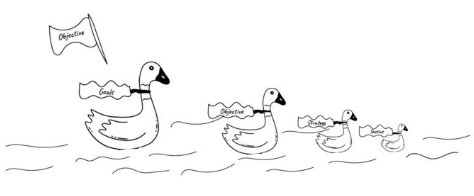The Unseen Force Driving B2B Marketing Success
The Silent Partner: 5 Ways Strategic Communication Supercharges Marketing...
January 22, 2024
Imagine a serene duck gliding gracefully on the surface of a tranquil pond. Above the surface, the duck appears effortless, smooth, and unruffled, but beneath, there's a flurry of activity – a complex dance of webbed feet propelling the duck forward.
Think of marketing as everything above the surface. And that hidden force beneath the water? That’s strategic communication – the powerful yet often underestimated component that can help drive business-to-business (B2B) marketing success.
As beautiful as marketing may look above the surface, here’s how strategic communication can support and enhance marketing: ...
Conquer Your Market: Data-Powered Audience & Stakeholder Analysis

Dominating your market isn't a fantasy. It's about identifying who truly matters. Here's how data analysis can transform you into a communication champion and propel you to the top.
Data Drives Smart Communication
As with data-driven marketing strategies, communication strategies rely on data – market research, internal insights, first-party data, and more – to understand your audiences (those who receive your message) and stakeholders (those invested in your success).
While marketing traditionally focuses on external audiences (your customers), communicators are concerned with understanding ALL external and internal audiences and stakeholders.
Who's who in this audience zoo?
It can get confusing! Here's a quick breakdown:
- Stakeholders: These are the folks directly or indirectly impacted by your company. They could be your boss, employees, investors, or even regulatory bodies. Communication with them is often a two-way street.
- Audiences: These are the receivers of your message, whether it's customers, potential clients, media, or your local community. Communication with them typically flows one way, from you to them.
How do you know whether you're addressing an
audience or a stakeholder? Figure out how you interact with each group. Are you simply broadcasting a message, or is there a back-and-forth?
Why This Matters
Ignoring key stakeholders or failing to inform crucial audiences can be a recipe for disaster. Data analysis helps you avoid this by pinpointing the right people and crafting targeted messages that resonate.
B2B Success: Unlocking Hidden Gems Data isn't just about crushing the competition – it's about uncovering hidden advantages that give you the upper hand. Take your employees, for example. They often possess a wealth of knowledge about
your customers. By actively listening to their insights and leveraging their expertise, you can unlock game-changing ideas for product improvement and gain a deeper understanding of your market.
Chart Your Course: How a Mapped B2B Customer Journey Drives Success

Marketing drives customers to your door, but what happens once they walk in?
A well-mapped
customer journey is the key to B2B success. It helps you understand the steps your prospects take, from initial research to purchase decisions. This knowledge empowers you to:
- Attract the right prospects
- Address their needs and preferences
- Clear any doubts they may have
- Streamline the buying process
The result? Satisfied, loyal customers who fuel your long-term growth.
Beyond the Doorstep: Why B2B Needs Strategic Communication
Marketing traditionally focuses on external audiences – your customers. But the journey doesn't end there. Strategic communication bridges the gap by ensuring:
- Internal stakeholders (like employees) understand their role in delivering a smooth customer experience.
- Customers know what to expect every step of the way.
The B2B Customer Journey Puzzle: Putting the Pieces Together
Imagine the B2B customer journey as a puzzle – complex and ever-changing. Internal roadblocks, like communication gaps between marketing and sales, can make solving it even trickier.
This is where strategic communicators come in. They work alongside operations to:
- Identify key stakeholders: Who are the people involved in the customer journey internally?
- Understand communication styles: How do these stakeholders prefer to communicate?
- Pinpoint roadblocks: What communication or process issues are hindering the customer experience?
- Align internal teams: What steps can be taken to ensure everyone is working towards the same goal – customer satisfaction?
By tackling these challenges, strategic communication helps you create a seamless customer journey that drives B2B success.
Speak with One Voice: The Power of Consistent Messaging in B2B

Imagine your B2B company is at a trade show. But instead of a unified presentation, each department has its own message. Confusing, right?
That's what happens when your messaging lacks
consistency. Here's why a clear, consistent message is crucial for B2B success:
- Strength in Numbers: Consistent messaging across advertising, content, social media, and even employee interactions reinforces your brand values, mission, and Unique Value Proposition (USP). It's like a constant reminder of what makes your company special.
- Building Trust & Recognition: When your message is consistent, stakeholders (investors, partners), customers, and even employees get a clear picture of your brand. This builds trust and makes you more recognizable in the marketplace.
- The Customer Journey Lifeline: Consistency is especially important for B2B customers who navigate a complex buying journey. A clear, consistent message acts as a guide, ensuring they understand your value proposition at every touchpoint.
In short, consistent messaging isn't a nicety – it's the foundation for strong B2B relationships and lasting success.
Stop Wasting Time: Align Your Marketing Efforts for B2B Success

Have you ever felt the pressure to "fix" marketing with quick solutions? Statements like, "We need a new website!" or "Let's boost social media!" might sound good initially, but without a plan, they can waste resources.
This is where
communication strategy comes in. It helps you avoid this trap by using a framework called Goals, Strategies, Objectives and Tactics (GOST) to ensure your marketing efforts are aligned and deliver results.
Here's how GOST helps B2B businesses succeed:
- Clear Goals: Start with defining your overall marketing goals. What do you want to achieve? Increase brand awareness? Generate leads? Boost sales?
- Targeted Strategies: Once you have goals, develop specific strategies to reach them. This might involve content marketing, social media engagement, or public relations efforts.
- Measurable Objectives: Break down your strategies into achievable, measurable objectives. Use the SMART criteria (Specific, Measurable, Achievable, Relevant and Time-bound) to set clear targets.
- Aligned Tactics: Finally, identify the specific tactics you'll use to achieve your objectives. This could be anything from creating blog posts to attending industry events.
The Benefits of Planning Before Acting
By following the
GOST strategy framework, you avoid jumping into tactics without a clear plan. This ensures your marketing efforts are:
- Data-driven: Backed by research and market insights, leading to a higher chance of success.
- Focused: Directed towards achieving specific goals, maximizing your ROI.
- Cohesive: All your marketing activities work together to create a unified message for your target audience.
Real-World Example
Imagine a B2B client who wants to launch a campaign for their service department. However, after discussions using the GOST framework, a deeper issue is revealed. They struggle to connect with the industrial sector and can't even get callbacks.
The solution isn't just a marketing campaign. It might involve:
- Renaming the business unit to better reflect their industrial expertise.
- Updating their website landing page to showcase relevant services.
- Creating content that addresses the specific needs of industrial customers.
By addressing these foundational challenges first, the B2B company sets itself up for success before launching any prospect-focused campaigns.
Shield Your Business: Proactive Communication for B2B Success

Things don't always go according to plan, and unexpected challenges can threaten your B2B success. That's where strategic communication comes in as your secret weapon. Here's how it helps you navigate rough waters:
- Crisis Ready: Every company should have a Crisis Management Plan (CMP) outlining communication protocols for emergencies. Strategic communicators play a key role by:
- Developing clear communication strategies with stakeholders during a crisis to minimize reputational damage.
- Ensuring business continuity by keeping everyone informed and on the same page.
- Preventing Problems Before They Start: Strategic communicators don't just react to crises; they proactively identify potential issues. They use tools like a SWOT analysis (Strengths, Weaknesses, Opportunities, Threats) to:
- Uncover vulnerabilities in your business that could lead to problems.
- Identify opportunities to strengthen your position in the market.
By combining crisis planning with proactive risk assessment, you create a shield for your B2B business. This allows you to:
- Communicate transparently during difficult times, reducing negative impact.
- Head off potential crises before they escalate, saving time and resources.
Imagine the peace of mind knowing you have a plan in place to handle whatever comes your way. Strategic communication is your key to building a resilient B2B business that can weather any storm.
Flying High or Grounded: Strategic Communication's Role in Marketing Clarity
 How can you tell if your marketing needs more strategic communication?
How can you tell if your marketing needs more strategic communication?
- Low ROI: Is your marketing spend not delivering the results you expect?
- Sales Disconnect: Are your marketing efforts not translating into leads or sales?
- Website Woes: Like a canary in a coal mine, a website content audit can help assess the need for a unified strategic communication plan.
Need help? We're here for a chat or a courtesy website audit – let's get those ducks in a row!
 Talk to a person
Talk to a person








